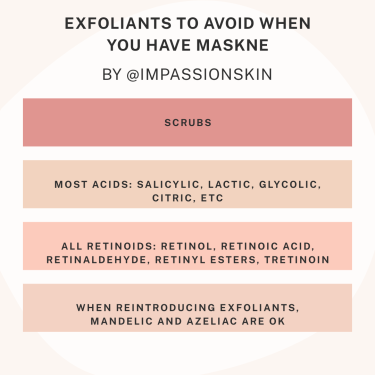How to Treat and Prevent Maskne (Updated May 17, 2021)

Maskne posts are probably done to death, but this subject bears repeating, as it’s an ongoing issue. Experiencing a sudden change to your skin can be stressful and you may need to adjust the products in your routine to accommodate it. Here is my personal take on how to treat and prevent maskne (a.k.a. acne mechanica). Most of these tips also apply when treating any sensitive skin condition.
1) Use disposable masks or respirators, instead of reusable ones. Disposable masks are known to be effective for preventing the spread of contagious illnesses. I’m all for being environmentally conscious, but unfortunately, laundry detergent, soaps, and fabric softener can lead to breakouts and other skin issues. Those kinds of detergents, fragrances, etcetera are not meant for prolonged exposure to the face. Choose a mask that fits well, so it is less likely to shift and chafe your skin. Just like skincare, finding a mask that fits your needs will require trial and error, until you find one that is suitable.
2) Avoid wearing base makeup at times when you are required to wear a mask. Makeup clogs pores and contains irritants. Wearing makeup exacerbates existing breakouts and irritation, especially when those conditions are not being treated properly. I recommend spot concealing in areas that your mask does not cover. You don’t need to wear foundation or concealer underneath the mask, as no one will be able to see that part of your face while you’re wearing it.
3) When you’re breaking out, you may feel an urge to exfoliate constantly. This isn’t necessarily the way to go. Too much exfoliation – and the wrong kinds of exfoliation – can lead to a damaged skin barrier. When this happens, you’re more likely to experience irritation. Bacteria is far more likely to penetrate into your skin when you have an impaired barrier. Thus, you are then more susceptible to breakouts. Your skin is already being chafed by masks, so breaking it down further with exfoliation likely won’t help you at this time. Give your skin a break. If you feel so inclined, you can use a spot treatment on active breakouts instead. When your skin’s barrier is more in tact, you can then reintroduce exfoliation. As a general rule of thumb, only exfoliate every 3 days. On a related note, you may need to switch to a more gentle cleanser, if you use one that contains exfoliants or harsh surfactants.
Barrier strengtheners: Ceramides, squalane, zinc, linoleic acid (fatty acids)
Gentle cleansers: Hale & Hush Quiet Wash, Ren Skincare Evercalm Gentle Cleansing Milk, Krave Beauty Matcha Hemp Hydrating Cleanser, CeraVe Hydrating Facial Cleanser, or La Roche-Posay Toleriane Milky Cleanser
4) Always treat inflammation before treating breakouts. You will get faster and better results this way. Use products containing the following ingredients:
Skin soothers and antioxidants: Oats, panthenol, beta glucan, licorice root, niacinamide, allantoin, tea extracts
Humectants: Glycerin, hyaluronic acid, snow mushroom, algae, urea
You don’t have to use each and every one of the ingredients listed. Always slowly introduce new products into your routine. When starting multiple new products, introduce each one individually and use it for a few days before starting the next one. If your skin is known to be reactive, be sure to patch testing new products before you apply them to your entire face.
I hope this post is helpful for anyone with the above skin conditions. Feel free to leave a comment below if you have any questions regarding this post.
Sources:





Leave a Reply